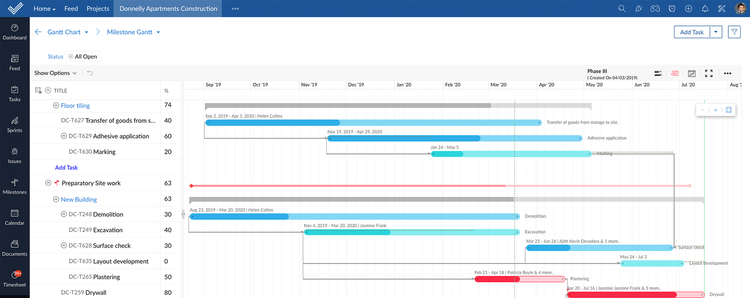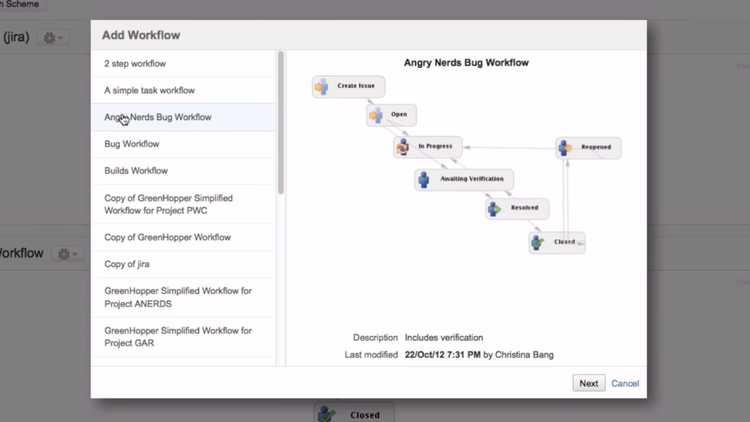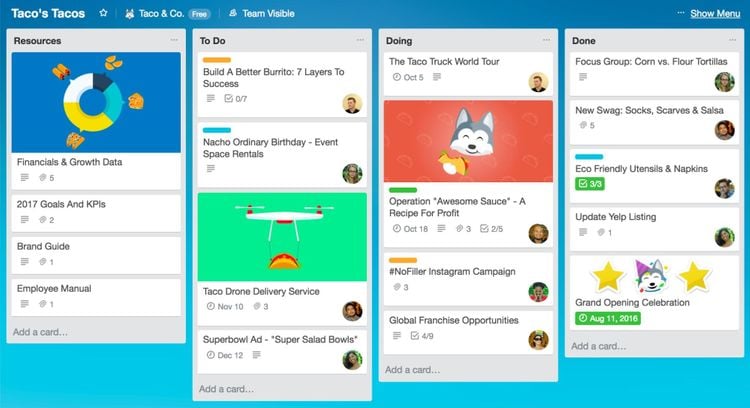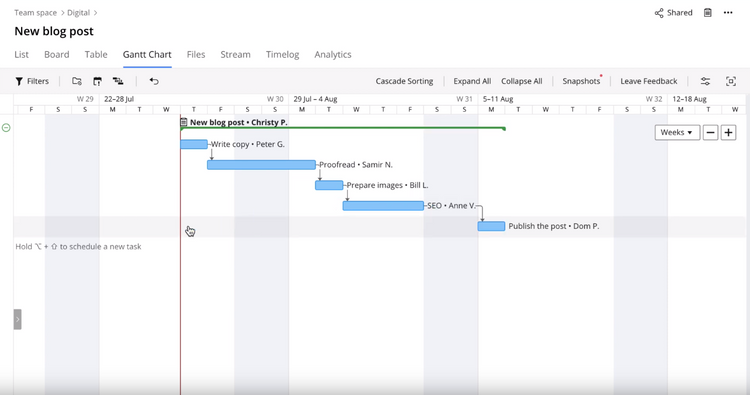8 Types of Project Management Methodologies and Which to Use
Every company requires some degree of project management and coordination of tasks along the production lifecycle. From planning and scheduling to quality checking and time tracking, a successful project manager is only as good as their method.
Fortunately, there are several popular methodologies ready to go for optimizing your project operations. Some of the most popular include:
- Waterfall
- Scrum board
- Agile
- Lean
- Kanban board
- Six sigma
- PRINCE2
- Critical path method
Finding the right method and utilizing a corresponding project management software is just one way to modernize your business processes.
8 Main Project Management Methods
Every project management methodology is intended to improve the decision making process on complex projects. To start, every project manager needs to identify the resources necessary to begin. This can range from employees to equipment. Then, project goals or milestones are set to create a gauge for how the project is progressing. Project managers keep track of these goals to ensure each task is completed on time and on (or under) budget.
There are a few commonalities among every method. First, general tasks lists contain rows and columns listing employees, tasks, due dates, progress, priority levels, and more customizable project information. Like advanced spreadsheets, these charts are essentially highly detailed to-do lists necessary to start product development with the best resources. Versions of these lists are found in almost all project management systems, including those described below.
Other similarities include:
- Scheduling tools
- Team collaboration
- Time tracking
In short, each methodology is intended to present project-related information in a manner that is as easy to digest as possible for managers and team members alike. The 8 most popular types of project management styles include:
Waterfall
One of the oldest styles of project management, this method’s visualization resembles a waterfall by breaking down tasks to be completed in a specific order, trickling down over the project timeline. This view is very popular with project managers who prefer a linear approach to completing tasks.
While the waterfall model originated in construction and manufacturing, this product management methodology has spread to every industry. The timeline’s straightforward nature makes it popular with projects that can be completed entirely in sequential stages. However, modified waterfall models have been designed to incorporate more complex subprojects.

Scrum Board
The scrum board method is based on prioritizing short development cycles, called sprints, iterations, or timeboxes, to optimize project completion. Visually showing the task and the length of time needed for completion allows project managers to plan ahead when it comes to meeting production deadlines.
The main categories on the board include:
- To do
- In progress
- Done
However, more are available based on the specifics of the project. The project manager or scrum master can update the board at any time to better meet all milestones, making it suitable for both traditional and modern project management styles. Overall, the focus of scrum project management is on time management, while many of the other methods look more at project organization as a whole regardless of a specific timeline.
Often included with scrum boards are burnup or burndown charts, which are oriented to display remaining project tasks against the project’s proposed end date. The X-axis shows the total number of necessary tasks, while the Y-axis is the timeline leading up to the end point. Most graphs also include a line indicating where the remaining work line should be to show how close the project is to completion. The goal is to monitor real-time performance to identify areas of improvement and catch any issues before they delay the estimated endpoint.

Agile
Agile project management, usually shortened to agile PM, is a popular and growing option for businesses across every industry. An agile project management system is an adaptive method for prioritizing tasks based on completed and remaining work. Agile PM solutions address real-time issues frequently encountered during software development.
The agile methodology is ideal for fast-moving teams, businesses, and industries that need a project management method that can easily handle change during the production cycle. It is a popular alternative for fast-moving project teams that lack predictable timetables and consistent project outcomes. It is also widely used in product management software, as it keeps production moving fast.

Lean
Lean project management, like the agile method, follows a set of principles to streamline operations. However, these principles are drawn from lean manufacturing rather than traditional project management, which emphasizes identifying waste and eliminating it completely from the production process.
Waste can be applied to anything that misuses resources during the development process, such as labor, materials, and equipment. Even waiting around for other tasks to finish can add up to bottlenecks. By removing waste from the project lifecycle, more focus can be given to overall process improvement.
Kanban Board
A Kanban board helps visualize project work through cards and columns. Each card or column represents a stage of the project and provides an easy way to visualize work both in progress and completed. Kanban project management itself is similar to the lean method in that it uses human systems to prevent bottlenecks and other production delays.
Kanban project management uses boards to break down visual signals (cards), columns, work-in-progress limits, employee assignments, and delivery points. The cards visualize tasks for teams and create a path showing their overall project workflow. From there, your cards will be arranged to show the ideal path to completion. Kanban boards even let you establish work-in-progress limits which is simply a cap to how many cards can be in one column at a given time.

Six Sigma
The Six Sigma methodology is designed to improve the customer experience by better understanding what they want. By focusing on customer satisfaction, the actual project timeline is highly fluid when incorporating real-time feedback into deliverables. While on the surface, this method appears to be more of a quality management system; it includes beneficial side effects such as the reduction of defects, unwanted features, and product waste.
PRINCE2
PRINCE2 is an acronym meaning “Projects IN Controlled Environments.” The UK government created PRINCE in 1989 for IT standards, and PRINCE2 came to be in 1996 as a general project management method. It’s known for its flexibility and emphasis on organization and documentation, making it a good option for larger projects and can be implemented using enterprise project management software. The seven steps of the method include:
- Starting a project
- Project direction
- Project initiation
- Controlling a stage
- Managing product delivery
- Managing a stage boundary
- Closing a project
Critical Path Method
The critical path method (CPM) is used to identify and schedule all critical tasks within a project. This is achieved by creating a model of the project that includes all activities, the duration of each task, all dependencies, and milestones for larger project phases. Using the model, you can then identify the longest sequence of critical tasks that need to be completed to complete the project on time.
The critical path method works best with small to midsize projects, as it can become too complicated to identify each timeline and task in a large-scale project. To follow the critical path effectively, you must adhere to strict deadlines and know them during planning.
Project Management Methods by Industry
Fast-paced organizations are more likely to need an agile PM to successfully keep up with the competition. In fact, different types of project management approaches can be brought together based on the project goals.
For example, IT project managers tend to prefer Kanban boards because they can accommodate so many interconnected cards, a necessary element of working with information technology. Six Sigma is ideal for companies looking to do a complete overhaul of their current operating system, while agile project management is ideal for fast-paced industries like marketing, construction, or food distribution.
Other options are preferred in different regions. PRINCE2 is used by the United Kingdom, Australia, and the countries of Western Europe in place of a Project Management Professional (PMP) preferred in the United States. As such, international corporations will need to carefully consider their project management options to ensure cohesion amongst team members in different countries.
Modern vs Traditional Project Management
The first mainstream project management tool was Gantt charts. The impact of these bar charts is still visible in modern methods, as the visual format eases communication and encourages teamwork across tasks.

Over time, the need for an agile approach became necessary to handle the growing project scope and streamline increasingly complicated processes. Gantt charts evolved into “critical path methods” (CPM), “responsible, accountable, consulted, informed” (RACI), and “program evaluation and review technique” (PERT). This, in turn, led to the scrum and Kanban methods before arriving at the current methodologies. Regardless of origin, all methodologies use the same set of principles to show project schedules and the interwoven relationships between various tasks.
Project management software has become a game changer in streamlining production. Instead of relying on members of your development team to physically check on a physical board, they can log in to see a virtual, continually updating board online. Everyone on the team, including stakeholders, can get instant, real-time updates on progress.
This visual view of project tasks lets you and your staff see what work is scheduled at varying times of the day, or further out into the production calendar. A modern methodology encourages teamwork and cooperation by detailing which employees are available to complete tasks in order to avoid interruption to project workflow.
While more traditional methods have fallen out of favor compared to more flexible solutions, there are still some advantages to using linear steps that cannot be rearranged once the project starts. They are particularly useful in certain circumstances, like managing small projects with limited scopes. Some of the older methodologies, such as the waterfall method, have managed to adapt and become more customizable to better fit in with shifting project dynamics.
Modern project management software provides one major advantage over old methodologies: retrospective analysis of past projects through historical data. Project managers can easily review what works, what doesn’t, and make changes to ensure future project success.
Selecting a Method
The right project management process is determined by both the company and individual development team. Sometimes, this can even change throughout the project’s phases. As described above, what works for one project manager may not be right for another, and different team members may respond better to different methods. It’s not uncommon for companies to mix and match various types of project management solutions to fully optimize their business processes.
Fortunately, there are hybrid options out there to make it easier to utilize different methods. For instance, Scrumban is a combination of Scrum and Kanban methodologies. Other custom styles have been developed by the Project Management Institute (PMI) by professional project managers worldwide. Different types of project management software make it possible to personalize your methods to best serve your preferred project plan.
